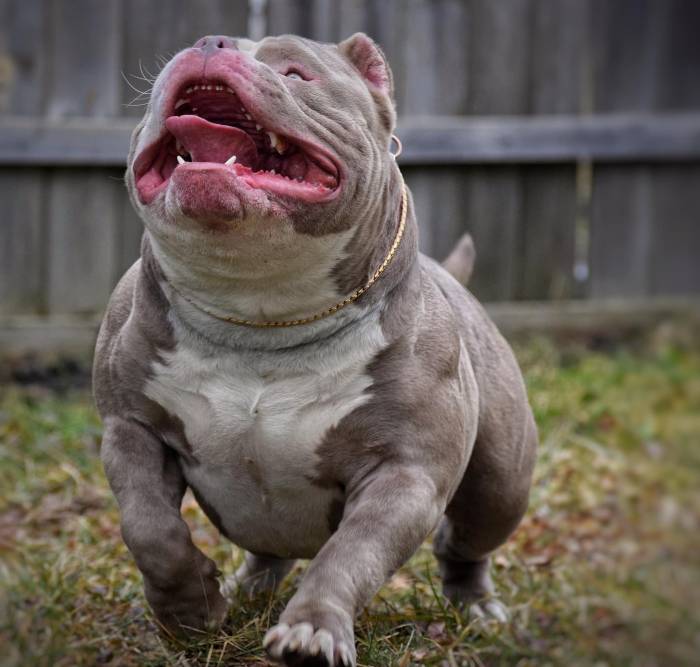Pocket bully puppy sets the stage for this enthralling narrative, offering readers a glimpse into a story that is rich in detail with sindonews author style and brimming with originality from the outset.
Pocket Bully Puppies are a fascinating breed with distinctive characteristics that make them stand out. From their physical features to their temperament and care requirements, there’s much to explore about these lovable companions.
Overview of Pocket Bully Puppy
Pocket Bully puppies are a smaller and more compact version of the American Bully breed. They are known for their muscular build, broad head, and strong appearance. Despite their size, Pocket Bullies are still quite agile and energetic.
Characteristics and Appearance
Pocket Bully puppies typically have a short coat that is smooth and glossy. They come in various colors and patterns, including brindle, fawn, blue, and black. These puppies have a wide chest, thick neck, and strong legs, giving them a powerful and sturdy look.
Origin and History
The Pocket Bully breed originated in the United States and is a result of breeding American Pit Bull Terriers, American Staffordshire Terriers, and various other bully breeds. The goal was to create a compact yet muscular dog that maintained the appearance of a bully breed.
Pocket Bullies have gained popularity for their friendly and outgoing nature, making them great companions for families.
Physical Features
Pocket Bully Puppies are known for their compact and muscular build, making them stand out among other bully breeds. These puppies have a strong and athletic appearance despite their small size.
Size and Build
Pocket Bully Puppies are smaller in size compared to other bully breeds like American Pit Bull Terriers and American Bullies. They typically weigh between 13 to 17 inches at the shoulder and can weigh anywhere from 30 to 60 pounds.
Despite their small stature, they have a thick and muscular build which gives them a powerful and stocky appearance.
Color Patterns and Markings
Pocket Bully Puppies come in a variety of color patterns and markings. Some common colors include brindle, fawn, blue, black, and white. These puppies may have unique markings such as patches, spots, or solid colors. Their coat can be glossy and smooth, further enhancing their overall appeal.
Temperament and Behavior
Pocket Bully Puppies are known for their friendly and affectionate nature, making them great companions for families. They are loving, loyal, and eager to please, which allows them to bond closely with their owners.
Intelligence and Trainability
Pocket Bully Puppies are intelligent dogs that pick up commands quickly. With consistent training and positive reinforcement, they can excel in obedience and agility training. It is important to start training early to establish good behavior habits.
Interaction with Children and Other Pets
Pocket Bully Puppies are generally good with children, being playful and gentle. However, it is crucial to supervise interactions to ensure both the puppy and the child are safe. When properly socialized, they can also get along well with other pets in the household, including cats and other dogs.
Care and Maintenance
Proper care and maintenance are essential to ensure the well-being and happiness of your Pocket Bully Puppy. Here are some guidelines to help you take care of your furry friend.
Grooming Requirements
Grooming your Pocket Bully Puppy is relatively easy due to their short coat. They require regular brushing to remove loose hair and minimize shedding. Bathing should be done as needed, using a mild dog shampoo to keep their coat clean and healthy.
Additionally, regular nail trimming, ear cleaning, and dental care are important aspects of grooming to maintain your puppy’s overall health.
Exercise Needs and Suitable Activities
Pocket Bully Puppies are active and playful, requiring regular exercise to stay fit and happy. Daily walks, playtime, and interactive toys are great ways to keep them mentally and physically stimulated. Engaging in activities like fetch, agility training, and obedience training can help burn off excess energy and strengthen your bond with your puppy.
Feeding, Vaccination, and Healthcare Tips
When it comes to feeding your Pocket Bully Puppy, it’s important to provide a balanced diet suitable for their age, size, and activity level. Consult with your veterinarian to determine the right amount and type of food for your puppy.
Regular vaccinations, flea and tick prevention, and deworming are crucial to protect your puppy from common illnesses and parasites. Schedule regular check-ups with your vet to monitor your puppy’s health and address any concerns promptly. Remember to provide fresh water at all times and avoid feeding them human food that may be harmful to their health.
Training and Socialization

Training and socialization are crucial aspects of raising a well-behaved and well-adjusted Pocket Bully puppy. Proper training methods and early socialization can greatly impact the behavior and temperament of this breed.
Effective Training Methods
- Use positive reinforcement techniques such as treats, praise, and toys to reward good behavior.
- Be consistent in your training approach and set clear boundaries and rules for your puppy to follow.
- Enroll your Pocket Bully puppy in obedience classes to provide structured training and socialization opportunities.
- Patience is key – remember that training takes time and consistency to see results.
Importance of Early Socialization
- Early socialization helps your Pocket Bully puppy to become comfortable in various environments and with different people and animals.
- Expose your puppy to different sounds, sights, and experiences to build their confidence and reduce the likelihood of fear or aggression in new situations.
- Regularly introduce your puppy to other dogs to help them develop good social skills and manners.
Tips for Addressing Behavioral Issues
- Address any behavioral issues promptly and consistently to prevent them from becoming ingrained habits.
- Consult with a professional trainer or behaviorist if you are struggling to manage your Pocket Bully puppy’s behavior.
- Provide plenty of mental and physical stimulation to prevent boredom, which can lead to destructive behaviors.
- Establish a routine for feeding, exercise, and training to create a sense of structure and predictability for your puppy.
Exercise and Activity
Pocket Bully Puppies are energetic and playful dogs that require regular exercise to maintain their physical health and mental well-being. It is essential to provide them with opportunities to burn off excess energy and stimulate their minds through various activities.
Exercise Needs
Pocket Bully Puppies need at least 30-60 minutes of exercise per day to stay happy and healthy. This can include activities such as brisk walks, running, playing fetch, or engaging in interactive games with their owners.
Importance of Mental Stimulation
Mental stimulation is crucial for Pocket Bully Puppies as it helps prevent boredom and destructive behaviors. Incorporating puzzle toys, obedience training, and scent games can keep their minds sharp and engaged.
Creating an Engaging Exercise Routine
To create an engaging exercise routine for your Pocket Bully Puppy, consider mixing up activities to keep them interested. Include a combination of physical exercise, mental stimulation, and social interaction with other dogs or humans. Additionally, be consistent with your routine to establish a healthy exercise habit for your puppy.
Living Environment

When it comes to providing the ideal living environment for a Pocket Bully Puppy, there are a few key factors to consider. These dogs thrive in a home where they receive plenty of attention, love, and care from their owners.
Suitability for Apartment Living, Pocket bully puppy
Pocket Bully Puppies can adapt well to apartment living as long as their exercise needs are met. They are relatively small in size, so they don’t require a large living space. However, it’s important to take them out for walks and playtime regularly to keep them happy and healthy.
Creating a Safe and Comfortable Space
- Provide a cozy bed or crate where your Pocket Bully Puppy can rest and feel secure.
- Ensure that the living space is free of any hazards or small objects that could be swallowed.
- Set up a designated area for your puppy’s food and water bowls to establish a routine.
- Keep the environment clean and tidy to prevent any accidents or health issues.
Health and Common Health Issues
Pocket Bully puppies, like any other breed, may be prone to certain health issues that owners need to be aware of in order to keep them healthy and happy. By taking preventive measures and practicing good healthcare habits, you can help ensure your Pocket Bully puppy lives a long and fulfilling life.
Common Health Issues
- Brachycephalic Syndrome: Due to their short muzzle, Pocket Bully puppies can experience breathing difficulties and may be prone to overheating. Keep them cool and avoid strenuous exercise in hot weather.
- Obesity: Pocket Bullies have a tendency to gain weight easily, so it’s important to monitor their diet and ensure they get enough exercise to maintain a healthy weight.
- Skin Issues: Some Pocket Bully puppies may develop skin allergies or sensitivities, which can lead to itching and discomfort. Regular grooming and proper nutrition can help prevent skin problems.
- Joint Problems: Like many small breeds, Pocket Bullies can be prone to joint issues such as luxating patella. Make sure they get regular exercise and maintain a healthy weight to reduce the risk of joint problems.
Preventive Measures and Healthcare Practices
- Provide a balanced diet with high-quality food to support your Pocket Bully’s overall health and well-being.
- Keep up with regular vet check-ups and vaccinations to ensure your puppy is protected against common diseases.
- Brush your Pocket Bully’s teeth regularly and provide dental chews to prevent dental issues.
- Monitor your puppy’s weight and adjust their diet and exercise routine as needed to prevent obesity.
Regular Vet Check-ups and Vaccinations
Regular vet check-ups are crucial for monitoring your Pocket Bully’s health and catching any issues early. Vaccinations are also important to protect your puppy from common diseases. Your vet will recommend a schedule for vaccinations based on your puppy’s age and risk factors.
Diet and Nutrition: Pocket Bully Puppy
When it comes to the diet and nutrition of your Pocket Bully puppy, it is essential to provide a balanced and appropriate diet to support their growth and development. Proper nutrition is crucial for their overall health and well-being.
Guidance on a Balanced Diet
To ensure your Pocket Bully puppy receives the necessary nutrients, it is recommended to feed them a high-quality commercial puppy food specifically formulated for small to medium-sized breeds. Look for options that list meat as the first ingredient and avoid foods with fillers or artificial additives.
Specific Nutritional Requirements
Pocket Bully puppies require a diet rich in protein to support muscle development. Additionally, they need adequate levels of fat for energy and skin health. It is important to choose a food that contains essential vitamins and minerals for proper growth.
Feeding Schedules and Portion Sizes
It is advisable to feed your Pocket Bully puppy small, frequent meals throughout the day to prevent overeating and aid digestion. Follow the feeding guidelines provided on the food packaging based on your puppy’s age, weight, and activity level. Monitor their body condition and adjust portion sizes accordingly.
Breeding and Puppy Care

Breeding and caring for Pocket Bully Puppies require a great deal of responsibility and dedication. Understanding the breeding practices and necessary care from birth to adulthood is crucial in ensuring the health and well-being of these adorable pups.
Breeding Practices
Breeding Pocket Bully Puppies should only be done by responsible and ethical breeders who prioritize the health and temperament of the dogs. It is essential to select breeding pairs carefully, focusing on genetic health, conformation, and temperament. Health testing for common breed-specific issues should be conducted to prevent passing on hereditary diseases to the puppies.
Moreover, breeding should aim to improve the breed standard and not prioritize exaggerated features that can lead to health problems.
Puppy Care from Birth to Adulthood
From the moment Pocket Bully Puppies are born, they require specialized care to ensure their healthy development. Proper nutrition, socialization, training, and veterinary care are essential components of raising a happy and well-adjusted pup. Newborn puppies need warmth, nutrition from their mother’s milk, and regular monitoring for any health issues.
As they grow, they should be introduced to various stimuli, people, and environments to build their confidence and prevent behavioral problems. Regular vet check-ups, vaccinations, and preventive care are vital throughout their life stages to maintain their overall well-being.
Responsible Breeding and Puppy Care Practices
Responsible breeding goes beyond simply producing puppies; it involves a commitment to the health and welfare of the dogs. Breeders should prioritize the health and temperament of the dogs over profit, ensuring that each breeding decision is made with the best interest of the puppies in mind.
Proper screening of potential owners, providing guidance on care and training, and being available for support throughout the dog’s life are all hallmarks of responsible breeding practices. Additionally, breeders should be transparent about their breeding practices, health testing results, and the conditions in which their dogs are raised to promote trust and accountability within the breeding community.
Legal Considerations

When it comes to owning a Pocket Bully Puppy, it’s crucial to be aware of any legal restrictions or regulations that may apply in your area. Understanding local laws and ordinances is essential to ensure you are in compliance and can provide the best care for your puppy.
This includes knowing about licensing, vaccinations, and registration requirements that may be mandated by your city or state.
Licensing and Registration
In many places, owning a dog, including a Pocket Bully Puppy, requires obtaining a license from the local authorities. This license usually involves registering your pet and ensuring they have up-to-date vaccinations. Failure to comply with licensing requirements could result in fines or other penalties.
It’s important to research and follow the specific regulations in your area to avoid any legal issues.
Vaccination Requirements
Vaccinations play a crucial role in the health and well-being of your Pocket Bully Puppy. Most jurisdictions have specific requirements for vaccinations to prevent the spread of diseases and protect both your pet and the community. Make sure to stay current on your puppy’s vaccinations and keep records as proof of compliance with local regulations.
Breed-Specific Legislation
Some areas may have breed-specific legislation that imposes restrictions on owning certain breeds, including Pocket Bullies. These laws may include regulations on ownership, breeding, or even outright bans on certain breeds. It’s important to be aware of any breed-specific legislation in your area to ensure you are in compliance and can provide a safe and loving home for your puppy.
Final Wrap-Up
In conclusion, Pocket Bully Puppies are not just pets but cherished members of the family. Understanding their needs, training them effectively, and providing a loving environment are key to raising a happy and healthy Pocket Bully Puppy.






